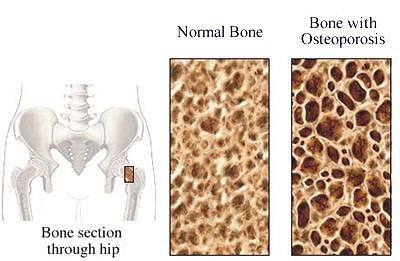<i>Prevent the silent killer</i>

As health-awareness is becoming an integral part of the modern lifestyle, bone-health has emerged as a key area of concern all over the world. Experts suggest that this is triggered by the fact that people, especially women, are increasingly suffering from different bone problems like.
Among the bone problems, osteoporosis is a major public health problem. Lots of people suffer from this problem which is easily preventable.
What is osteoporosis?
Osteoporosis, which means "porous bones," causes bones to become weak and brittle — so brittle that even mild stresses like bending over, lifting a vacuum cleaner or coughing can cause a fracture.
In most cases, bones weaken when you have low levels of calcium, phosphorus and other minerals in your bones. Osteoporosis can also accompany endocrine disorders or result from excessive use of drugs such as corticosteroids.
Common complications of osteoporosis
A common result of osteoporosis is fractures — most of them in the spine, hip or wrist. Although it is often thought of as a women's disease, osteoporosis also affects a significant number of men. And compared with the number of women and men who have osteoporosis, many more have low bone density.
What you need to know about your bones
Bones are constantly built and broken down.
With age, less and less bones are built to replace what is broken down.
After puberty, adequate calcium is a must for maintaining optimum bone-health.
No matter what your age, (if you can read this) bone health is important.
Owing to menstruation, childbirth, breastfeeding and menopause – women often suffer more from bone problems. But basic awareness from a young age can easily lead to adequate physical activity and calcium / mineral intake – which are the best ways to beat bone-problems later in life.
While this sounds very easy – the millions of women suffering from bone-problems around the globe testify to the contrary. Loss of bone strength and mass is a silent phenomenon – progressing unnoticeably as our bones turn fragile and brittle. It is often noticed only after a fracture occurs.
Preventing osteoporosis
It is never too late — or too early — to do something about osteoporosis. Everyone can take steps to keep bones strong and healthy throughout life.
Luckily, preserving bone-health often requires no extravagant diet, therapy, medication or treatment – but only basic awareness about our bones. For starters, it ought to be noted that bone is living tissue made up of specialised bone cells.
Like the rest of our bodies, it is constantly being broken down and renewed. In childhood, more bone is made than is broken down – approaching a balance by the end of puberty. From the mid-30s onwards, there is a mismatch between bone production and bone breakdown, resulting in a gradual decrease in bone strength and mass.
Calcium is a mineral needed by the body for healthy bones, teeth, and proper function of the heart, muscles, and nerves. Every cell in your body needs calcium. Your bones store calcium – and when there is dearth of it, your body takes it from your bones. And that can make your bones weak.
The body cannot produce calcium; therefore, it must be absorbed through food. Good calcium sources include dairy products, dark-green leafy vegetables, orange juice, cereal, bread, nuts and beans.
While many doctors prescribe calcium-supplements today, dietary calcium remains the best source for this precious mineral.
There are some milk powder in the market for the adults which can meet the dietary need to keep our bones healthy. These formula milks contain high calcium non fat / low fat and they are enriched with a superior combination of essential bone nutrients like Protein, Calcium, Magnesium, Zinc, and Vitamin D. Anlene is an example of such milk powder.
Few steps to healthy bones
Eat Healthy: Eat a healthy diet – plenty of fresh fruit, vegetables and whole grains. Avoid cigarette smoking and caffeine intake.
Ensure calcium for your body: Calcium is vital to building and maintaining strong, healthy bones and to aid functions of both muscle and the nervous system.
Be active: Regular weight-bearing exercises increase bone mass at all ages, stimulate bone growth and improve flexibility and co-ordination.
Essential minerals / micronutrients: Vitamin D and Magnesium help increase calcium absorption from the gastrointestinal system and kidneys, thus making it available to body tissues and the blood.
World osteoporosis day and its message
To create mass awareness about osteoporosis, World Osteoporosis Day is marked worldwide. Yesterday was this year's World Osteoporosis Day.
The messages of the 2007 World Osteoporosis Day campaign include:
· In youth, adequate exercise and bone-healthy nutrition are essential to build peak bone mass and reduce the risk of later fracture later in life
· Certain lifestyle actions are harmful to bone health at all ages: smoking, excessive alcohol consumption, poor nutrition or low body weight (eg. anorexia), lack of exercise
· Take positive action by practicing a bone-healthy lifestyle that includes weight-bearing exercise, calcium and vitamin-D rich nutrition
· Recognise whether you have passive risk factors (risk factors which you cannot change, but which you must be aware of such as family history of osteoporosis, prior fracture, thin build)
· Post-menopausal women should recognise that they are at greatest risk of osteoporosis and be especially aware of their personal risk and what questions to ask their physicians
· Men should be aware that they too are at risk of osteoporosis and that there are special considerations that should be recognised and acted upon
People who have experienced fractures are at high risk of future fractures and need to be especially vigilant and take appropriate preventative action.

 For all latest news, follow The Daily Star's Google News channel.
For all latest news, follow The Daily Star's Google News channel. 



Comments